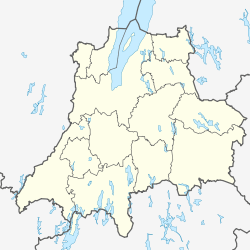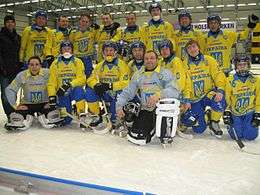Vetlanda
Vetlanda (![]()
Vetlanda | |
|---|---|
 Vetlanda Town Hall | |
 Vetlanda  Vetlanda | |
| Coordinates: 57°26′N 15°04′E | |
| Country | Sweden |
| Province | Småland |
| County | Jönköping County |
| Municipality | Vetlanda Municipality |
| Area | |
| • Total | 10.17 km2 (3.93 sq mi) |
| Population (31 December 2010)[1] | |
| • Total | 13,050 |
| • Density | 1,283/km2 (3,320/sq mi) |
| Time zone | UTC+1 (CET) |
| • Summer (DST) | UTC+2 (CEST) |
| Climate | Cfb |
History
Vetlanda was still nothing more than a village for several centuries. With the 1840s population boom in Småland, and the industrial revolution winning grounds in Sweden, the industry expanded and people settled in the village. With the railways crossing Vetlanda in the late 19th century the population further blossomed, and Vetlanda got the title of a city on New Year's Day 1920, at which time its population amounted to 3,015.
The coat of arms was selected as an ear of wheat, a derivation of the arms for the old jurisdiction Östra Härad (sv), wherein Vitala was rumoured to have been the centre, that depicted three ears of wheat. The present spelling Vetlanda did not come into use until the 1920s, before that it was known as Hvetlanda, a form that can be found in several companies and organizations.
In the 19th century, wood industry got a stronghold in Vetlanda, a position it still has today. Manufacturing is large in Vetlanda, besides wood industries there are also a strong metal industries and other factories.
Sport

Vetlanda also has two sports teams that compete in the highest league in their sports, Elit Vetlanda Speedway and Vetlanda bandyklubb. VBK has won the Swedish bandy championship three times, 1986, 1991 and 1992 and European Cup once, 1991. Skirö-Nävelsjö Bandy, playing in the second-tier Allsvenskan, is also situated in Vetlanda.
In 2013 the B-pool of the Bandy World Championship was played in Vetlanda.
Notable natives
- Elitserien ice hockey player Alexander Ytterell (born July 1, 1991)
- NHL ice hockey player Johan Franzén (born December 23, 1979)
- NHL ice hockey player Mattias Tedenby (born February 21, 1990)
- NHL ice hockey player Erik Karlsson (born May 31, 1990)
- Sculptor Peter David Edstrom (born March 27, 1873)
- Singer and media personality Lena Philipsson (born January 19, 1966)
- Music producer and songwriter Putte Nelsson (born December 5, 1971)
- Thomas H Jonasson Speedway Rider (born November 27, 1988)
- Anastasia Michaelsdotter Supermodel, activist and director (born September 12, 1996)
References
| Wikimedia Commons has media related to Vetlanda. |
- "Tätorternas landareal, folkmängd och invånare per km2 2005 och 2010" (in Swedish). Statistics Sweden. 14 December 2011. Archived from the original on 27 January 2012. Retrieved 10 January 2012.